
Catalog excerpts

Technical Information (Revised 2005.6)
Open the catalog to page 1
ZYLON®(PBO fiber) Technical Information (2005) Contents 1. Basic properties 2. Comparison with other high-performance fibers 3. Influence of twist on tensile properties 4. Creep properties 5. Thermal behavior 5.1 TGA Analysis 5.2 Isothermal weight loss 5.3 Strength retention after thermal treatment 5.4 Strength retention at high temperature with humidity 5.5 Effect of temperature on strength and modulus 5.6 Hot air shrinkage 5.7 Flame resistance 5.8 Combustion products 6. Light resistance 7. Chemical resistance 7.1 Organic mediums 7.2 Inorganic mediums 7.3 Seawater 8. Moisture pick-up 9....
Open the catalog to page 2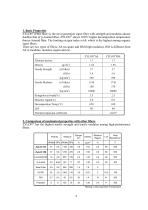
1. Basic Properties ZYLON®(PBO fiber) is the next generation super fiber with strength and modulus almost doubles that of p-Aramid fiber. ZYLON® shows 100°C higher decomposition temperature than p-Aramid fiber. The limiting oxygen index is 68, which is the highest among organic super fibers. There are two types of fibers, AS (as spun) and HM (high modulus). HM is different from AS in modulus, moisture regain and etc. ZYLON® AS Moisture regain(%) Decomposition Temp.(°C) Tensile Strength Tensile Modulus Thermal expansion coefficient 2. Comparison of mechanical properties with other fibers...
Open the catalog to page 3
The stress-strain curves of ZYLON® compared with other high-performance fibers are shown below. 6 Zylon HM p-Aramid p-Aramid HM copoly-Aramid Carbon 3. Influence of twist on tensile properties ZYLON® is shipped with zero twist. A certain twist has to be applied in order to measure its correct tensile strength. These figures show the influence of twist factor on tensile strength and modulus for 555 dtex ZYLON® yarn. For different dtex yarns, optimum twist level can be estimated by using twist factor. Twist factor is defined by the following formula. Twist factor (TF) = 0.124 x (turns per...
Open the catalog to page 4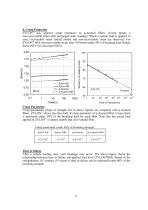
4. Creep Properties ZYLON® has superior creep resistance to p-Aramid fibers. (Creep means a non-recoverable strain after prolonged static loading.) When a certain load is applied to yarn, recoverable strain (initial strain) and non-recoverable strain are observed. For ZYLON® HM, non-recoverable strain after 100 hours under 50% of breaking load (Safety factor (SF)=2) is less than 0.03%. 2.00 Stress(% of breaking load) 1.50 1.25 1.00 Zylon AS Zylon HM p-Aramid p-Aramid HM Creep Parameter Creep parameters (slope of straight line in above figure) are compared with p-Aramid fibers. ZYLON® shows...
Open the catalog to page 5
5. Thermal properties 5.1 Decomposition Temperature ZYLON® has a 100°C higher decomposition temperature than p-Aramid fibers. Thermal gravimetric analysis charts in air and argon gas are shown below. The heating rate is 20°C/min. Zylon AS Zylon HM p-Aramid p-Aramid HM copoly-Aramid Zylon AS Zylon HM p-Aramid p-Aramid HM copoly-Aramid 5.2 Isothermal weight loss A significant difference of weight loss behavior is observed at 500°C between ZYLON® and Aramid fibers. 100 Residual Weight(%) Residual Weight(%) 60 40 Zylon AS Zylon HM p-Aramid p-Aramid HM copoly-Aramid 80 60 40 Zylon AS Zylon HM...
Open the catalog to page 6
5.3 Strength retention after thermal treatment These figures show the effect of thermal treatment in air on residual strength. ZYLON®HM shows a little higher heat resistance than ZYLON®AS. 100 Strength Retention(%) Strength Retention(%) Strength retention after thermal treatment is compared with Aramid fibers at several temperatures. 100 Strength Retention(%) Strength Retention(%) 40 Zylon AS Zylon HM p-Aramid p-Aramid HM copoly-Aramid
Open the catalog to page 7
Strength Retention(%) Strength Retention(%) Zylon AS Zylon HM p-Aramid p-Aramid HM copoly-Aramid p-Aramid p-Aramid HM copoly-Aramid Zylon AS Zylon HM p-Aramid HM copoly-Aramid Strength Retention(%) Zylon AS Zylon HM p-Aramid p-Aramid HM
Open the catalog to page 8
5.4 Strength retention at high temperature with humidity The strength of ZYLON® decreases in the condition of high temperature and high humidity. The residual strength after a 50 hours treatment with saturated steam at 180°C is 40-50%, which is between p-Aramid and copoly-Aramid fiber. p-Aramid copoly-Aramid p-Aramid copoly-Aramid Strength Retention(%) Strength Retention(%) The strength of ZYLON® gradually decreases even at the temperature of less than 100°C in high humidity condition. ZYLON® fiber should be stored free from high humidity at normal room temperatures. 40 Room temperature and...
Open the catalog to page 9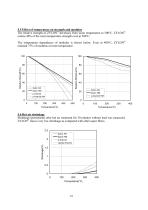
5.5 Effect of temperature on strength and modulus The relative strength of ZYLON® decreases from room temperature to 500°C. ZYLON® retains 40% of the room temperature strength even at 500°C. The temperature dependence of modulus is shown below. Even at 400°C, ZYLON® retained 75% of modulus at room temperature. Relative Strength(%) 40 Zylon AS Zylon HM p-Aramid p-Aramid HM 40 Zylon AS Zylon HM p-Aramid HM 5.6 Hot air shrinkage Shrinkage (permanent) after hot air treatment for 30 minutes without load was measured. ZYLON® shows very low shrinkage as compared with other super fibers. 2.5 Zylon...
Open the catalog to page 10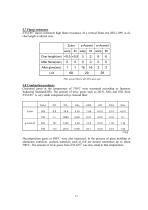
5.7 Flame resistance ZYLON® shows extremely high flame resistance. In a vertical flame test (JIS L1091 A-4), char length is almost zero. Zylon warp Char length(cm) <0.5 <0.5 After flame(sec) After glow(sec) Plain woven fabrics with 20's spun yarn 5.8 Combustion products Generated gases at the temperature of 750°C were measured according to Japanese Industrial Standard(JIS). The amount of toxic gases such as HCN, NOx and SOx from ZYLON® is very small compared with p-Aramid fiber. Decomposition gases at 500°C were also measured. In the process of glass molding or aluminum extrusion, cushion...
Open the catalog to page 11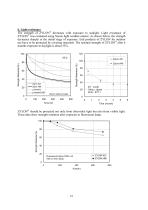
6. Light resistance The strength of ZYLON® decreases with exposure to sunlight. Light resistance of ZYLON® was evaluated using Xenon light weather-ometer. As shown below, the strength decreases sharply at the initial stage of exposure. End products of ZYLON for outdoor use have to be protected by covering materials. The residual strength of ZYLON® after 6 months exposure to daylight is about 35%. 120 Strength Retention(%) 40 Zylon AS Zylon HM p-Aramid p-Aramid HM Time (month) ZYLON® should be protected not only from ultraviolet light but also from visible light. These data show strength...
Open the catalog to page 12All Imattec catalogs and technical brochures
-
IMAT'Fire
1 Pages
-
STAINLESS STEEL FIBRES
1 Pages
-
What are you looking for ?
1 Pages





